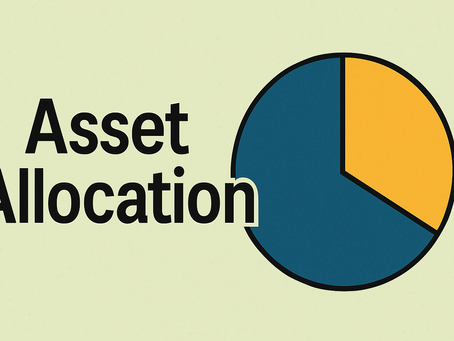top of page

Blog


Financial Word of the Day: Home Bias
Definition of Home Bias
Home Bias is the tendency for investors to heavily favor investments from their own country while underinvesting in international markets.
In plain English: we like what’s familiar. We buy U.S. stocks, U.S. bonds, U.S. real estate… and quietly ignore the rest of the world—even though the global economy is much bigger than just us.
From a comfort standpoint, that makes sense. From a wealth-building standpoint, it can quietly hold you back.

Larry Jones
3 days ago2 min read


Financial Word of the day: Status Quo Bias
A Simple Definition of Status Quo Bias
Status Quo Bias: The tendency to stick with your current financial choices—accounts, habits, subscriptions, investments—even when changing them would clearly benefit you.
It’s not laziness. It’s wiring. Your brain interprets “same” as “safe,” even when “same” is sinking your wallet.

Larry Jones
4 days ago2 min read


Financial Word of the Day: Recency Bias
Definition of Recency Bias
Recency Bias is the tendency to give more weight to the most recent information we’ve seen—while ignoring long-term data, history, and trends. In simple terms: what just happened feels more important than what usually happens.
And in money decisions, that can get expensive fast.

Larry Jones
5 days ago2 min read


Financial Word of the Day: Representativeness
Definition of Representativeness
Representativeness is a mental shortcut (bias) where we assume something belongs to a certain category because it looks like a typical example—even when the actual data doesn’t support that conclusion.
In plain English: “This reminds me of that… so it must be that.”
Our brains love patterns. The problem? Sometimes we see patterns that aren’t really there—especially with money.

Larry Jones
6 days ago2 min read


Financial Word of the Day: Availability Heuristic
Definition of Availability Heuristic
The availability heuristic is a mental shortcut where we judge how likely something is based on how easily examples come to mind—rather than on actual data or probabilities.
In plain English: If you can remember it easily, your brain thinks it happens all the time. And in money decisions, that can get expensive.

Larry Jones
7 days ago2 min read


Financial Word of the Day: Mental Accounting
What Mental Accounting Means (in plain English)
Mental accounting is the habit of mentally dividing your money into different “buckets” based on where it came from or what you think it’s “for”—even though every dollar you own is actually just… a dollar.
Your brain does this automatically because it wants the world to feel organized. But here’s the catch: Those mental labels can lead you straight into bad decisions, missed opportunities, and slower wealth-building.

Larry Jones
Dec 53 min read


Financial Word of the Day: Cognitive Dissonance
What Cognitive Dissonance Means
Cognitive Dissonance is the discomfort your brain experiences when you hold two conflicting beliefs at the same time — especially about money.
You know you should budget……but you also want to believe you “deserve” that impulse purchase.
You know your credit card balance is climbing……but you still believe you’re “good with money.”
You know an investment is performing poorly……but you believe selling it would mean admitting you made a mistake.

Larry Jones
Dec 42 min read


Financial Word of the Day: Prospect Theory
What Prospect Theory Means (Plain English Version)
Prospect Theory explains why people make decisions based on how choices are framed—especially when facing gains and losses. In short:
- We hate losing more than we like winning.
- We’re risk-averse with gains but weirdly risk-seeking with losses.
- Our emotions often override the math.

Larry Jones
Dec 32 min read


Financial Word of the Day: Framing
Definition of Framing
Framing is the way information is presented in order to influence how we perceive value and make financial decisions. The facts don’t change—only how those facts are described. But our brain reacts differently depending on the “frame.”

Larry Jones
Dec 22 min read


Financial Word of the Day: Confirmation Bias
Definition of Confirmation Bias
Confirmation bias is our natural tendency to search for, believe, and remember information that supports what we already think is true—while ignoring anything that challenges our opinion. When it shows up in money decisions, it can push us into bad investments, risky purchases, or just plain stubborn financial mistakes because we convince ourselves we’re already right.

Larry Jones
Dec 12 min read


Financial Word of the Day: Anchoring
A Simple Definition of Anchoring
A behavioral bias where we fixate on an initial price, value, or piece of information and use it to make ongoing decisions—often leading to bad financial choices.

Larry Jones
Nov 282 min read


Financial Word of the Day: Overconfidence
Definition of Overconfidence
Overconfidence (in finance) is a behavioral bias where investors believe they have better knowledge, sharper instincts, or more accurate predictions than they actually do. This confidence leads them to take bigger risks, ignore danger signs, and make decisions based on gut feelings instead of solid strategy.

Larry Jones
Nov 272 min read


Financial Word of the Day: Herding
Definition of Herding
Herding is when investors blindly follow what everyone else is doing instead of making decisions based on actual research, fundamentals, or strategy. It’s jumping into the market simply because “everybody’s buying” or dumping your investments just because “everyone is selling.”

Larry Jones
Nov 262 min read


Financial Word of the Day: Loss Aversion
Definition of Loss Aversion
Loss aversion describes our natural tendency to hate losing money more than we enjoy gaining money. In fact, most people feel the pain of a loss about twice as strongly as the joy of a gain. That emotional imbalance leads many folks to make defensive, fearful, or flat-out irrational money decisions.

Larry Jones
Nov 252 min read


Financial Word of the Day: Behavioral Finance
Definition of Behavioral Finance
Behavioral finance is the study of how our emotions, habits, and quirks influence our financial decisions. In a perfect world, people would invest, save, and spend based on facts and logic. But we don’t—we’re human. We tend to follow the crowd, panic when markets dip, overspend when we’re stressed, and cling to bad investments because we “feel” they’ll bounce back.

Larry Jones
Nov 242 min read


Financial Word of the Day: Random Walk Theory
Definition of Random Walk Theory
Random Walk Theory says that stock prices move in random, unpredictable ways because all available information is already baked into the price. In other words, the market doesn’t care about your predictions, your gut feelings, or your uncle Joe’s “can’t-miss stock tips.” Prices just… wander.

Larry Jones
Nov 212 min read


Financial Word of the Day: Efficient Market Hypothesis
Definition of Efficient Market Hypothesis (EMH)
The Efficient Market Hypothesis (EMH) says this: All publicly available information is already baked into current stock prices — instantly.
In other words, you can’t consistently “out-smart” the market by finding hidden gems, secret tips, or under-the-radar opportunities… because the market has already priced those in. Like, immediately.
According to EMH, the only way to beat the market is by taking more risk — not by being s

Larry Jones
Nov 202 min read


Financial Word of the Day: Modern Portfolio Theory
Definition of Modern Portfolio Theory (MPT)
Modern Portfolio Theory is the idea that you can improve your investment results not by picking perfect individual stocks, but by building a blend of different investments that work well together.
The goal? Maximize your return while minimizing your risk.
In other words: Don’t bet the farm on one horse. Build a team where each player brings something different to the field.

Larry Jones
Nov 192 min read


Financial Word of the Day: Asset Allocation
What Is Asset Allocation?
Asset allocation is the strategy of dividing your investments across different “buckets” — typically stocks, bonds, and cash — based on your goals, your time horizon, and how much risk you can stomach without losing sleep or stress-eating Chips Ahoy at midnight.
Think of it like building a balanced meal.
Stocks = protein
Bonds = veggies
Cash = carbs

Larry Jones
Nov 182 min read


Financial Word of the Day: Rebalancing
What Is Rebalancing?
Rebalancing is the periodic process of adjusting your investment portfolio back to its original target mix. In plain English: the market shifts, your allocations drift, and you move things around to get everything back where it’s supposed to be.
If your plan says 70% stocks and 30% bonds, but stocks had a monster year and now you’re sitting at 82/18, rebalancing is the reset button.

Larry Jones
Nov 172 min read
bottom of page